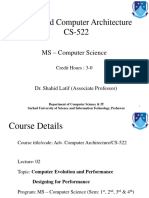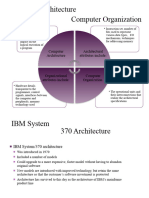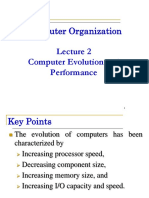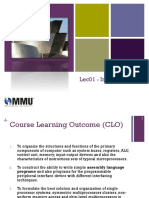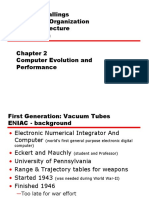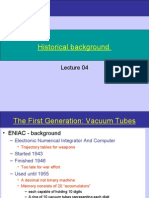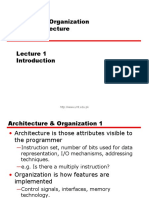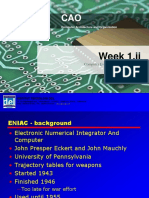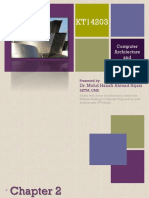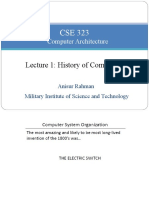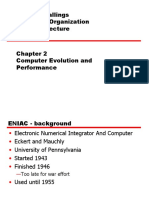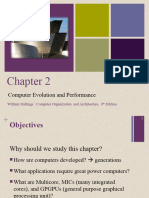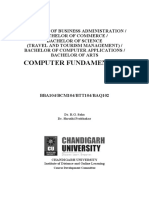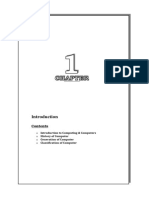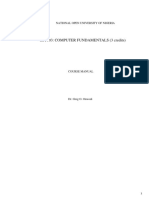Contact WEB: http://eee.deu.edu.tr/~ozkurt/comporg.htm E-mail: ahmet.ozkurt@deu.edu.tr ozkurt@eee.deu.edu.
tr
Computer Organization and Architecture Dr. Ahmet zkurt DEUEEE
YAAR UNIVERSITY, 2005
based on Chapter 1-2 of Computer Organization and Architecture William Stallings
Content
Week 1 2 3 4 5 6 7 8 9 10 11 12 13 14 CONTENT Introduction to Computer Organization and Architecture, Comparison, Structure and Function, Why Organization, Computer Basics History of Computers, Computer Evolution, Design and Performance Considerations Computer Structure, Components, Functions, Bus Interconnection Memory, Input-Output Units, Operating System Instruction Methodology, Instuction Cycle, Instruction types First Midterm Exam, Exam Discussion Central Processing Unit-1: Computer Arithmetic, Instruction Sets, Central Processing Unit-2: Addressing Modes and Formats, CPU Structure Control Unit, Input-Output Organization Memories and Memory Organization Software and Operating System Organization Computer Architectures, Von-Neumann Architecture, RISC Computers, Parallel Processing Second Midterm Exam, Exam Discussion
References Computer Organization and Architecture
William Stallings, 2003, VI edition
Computer System Architecture
M. Morris Mano, 1993, III edition
Computer Organization
V.C. Hamacher, Z.G.Vranesic,S. G. Zaky, 1996, IV edition
�Grading
Architecture & Organization 1 Architecture is those attributes visible to the programmer
Instruction set, number of bits used for data representation, I/O mechanisms, addressing techniques. e.g. Is there a multiply instruction?
30% Midterm I 40% Midterm II 20% HW+Presentation 10% Attendance
Organization is how features are implemented
Control signals, interfaces, memory technology. e.g. Is there a hardware multiply unit or is it done by repeated addition?
Architecture & Organization 2 All Intel x86 family share the same basic architecture The IBM System/370 family share the same basic architecture since 1970 This gives code compatibility
At least backwards
Structure & Function A hierarchical system is a set of interrelated subsystems, each of the latter, in turn, hierarchical in structure until we reach some lowest level of elementary subsystem. Structure is the way in which components relate to each other Function is the operation of individual components as part of the structure
Organization differs between different versions
�Function All computer functions are:
Data processing Data storage Data movement Control
Operations (1) Data movement
Operations (2) Storage
Operation (3) Processing from/to storage
�Operation (4) Processing from storage to I/O
Structure - Top Level
Computer
Input/Output
Main Memory
System Interconnection
CPU
Central Processing Unit
Registers
ALU
CPU Interconnection
Control Unit
Computer Organization Synonymous with architecture in many uses and textbooks We will use it to mean the underlying implementation of the architecture Transparent to the programmer An architecture can have a number of organizational implementations Control signals Technologies Device implementations
Computer
�Basic Computer
X Y
X1 Y1 Enable1
Function 1
Out1
Function select
. . .
. . .
X6 Y6 Enable6
Function 6
Out6
Chapter 2 Computer Evolution and Performance
A basic computer making several operations like addition, multiplification Requires Command decoding Requires data Requires data and output seperation / combination Requires function implementtaion
ENIAC - background Electronic Numerical Integrator And Computer Eckert and Mauchly Constructed in University of Pennsylvania Trajectory tables for weapons Started 1943 Finished 1946
Too late for war effort
ENIAC 1946
Used until 1955
It was U shaped, 25m long, 2.5m high and 1m wide
�ENIAC - details
Decimal (not binary) 20 accumulators of 10 digits Programming was done by plugging cables and setting switches. Data was entered by punched cards. Programming for typical calculations took from half a hour to a day. 18,000 vacuum tubes (reliability problem) 30 tons 140 kW power consumption (enough to light a small town) 5,000 additions per second
John Von Neumann
Von Neumann (mathematician) was a consultant to both ENIAC and EDVAC (Electronic discrete variable computer) projects Proposal of Neumann EDVAC: Basic elements of the stored-program computer A memory containing both data and instructions A calculating unit capable of performing both arithmetic and logical operations on the data A control unit, which could interpret an instruction retrieved from the memory and select alternative courses of action based on the results of previous operations Princeton Institute for Advanced Studies IAS (prototype of all subsequent general-purpose computers) Started in 1946, Completed in 1952
Structure of von Neumann machine
IAS - details 1000 x 40 bit words
Binary number 2 x 20 bit instructions
�Structure of IAS
Set of registers (storage in CPU) : Memory Buffer Register Memory Address Register Instruction Register Instruction Buffer Register Program Counter Accumulator Multiplier Quotient
IAS Instruction Set
IAS have 21 instructions which can be grouped as
Data transfer Unconditional branch Conditional branch (sign condition) Arithmetic Address modify
Commercial Computers 1947 - Eckert-Mauchly Computer Corporation UNIVAC I (Universal Automatic Computer) Became part of Sperry-Rand Corporation Late 1950s - UNIVAC II
Faster More memory
IBM Major manufacturer of punched-card processing equipment 1953 - the 701
IBMs first stored program computer Scientific calculations
1955 - the 702
Business applications
Lead to 700/7000 series
�Transistors
Replaced vacuum tubes Smaller Cheaper Less heat dissipation Solid State device Made from Silicon (Sand) William Shockley, Walter Brattain, and John Bardeen succeeded in creating the first pointcontact germanium transistor in1947 Bipolar junction transistor (Shockley) - 1950 Field effect transistor (MOS FET) - 1962
Transistor Based Computers
Second generation machines NCR & RCA produced small transistor machines DEC - 1957 Produced PDP-1 IBM 7000
IBM 700/7000 series (1952-1964)
IBM 7094
Microelectronics
Basic operations in a computer data storage data processing data movement control These operations can be performed by using gates and memory cells.
�Microelectronics Literally - small electronics The gates and memory cells can be manufactured on a semiconductor (1958) e.g. silicon wafer
SYSTEM
Generations of Computer
Vacuum tube - 1946-1957 Transistor - 1958-1964 Small scale integration - 1965 on Up to 100 devices on a chip Medium scale integration - to 1971 100-3,000 devices on a chip Large scale integration - 1971-1977 3,000 - 100,000 devices on a chip Very large scale integration - 1978 to date 100,000 - 100,000,000 devices on a chip Ultra large scale integration Over 100,000,000 devices on a chip
MODULE + GATE
CIRCUIT
DEVICE G S n+ D n+
Moores Law
Increased density of components on chip Gordon Moore - cofounder of Intel Number of transistors on a chip will double every year Since 1970s development has slowed a little
Number of transistors doubles every 18 months
Growth in CPU Transistor Count
Cost of a chip has remained almost unchanged Higher packing density means shorter electrical paths, giving higher performance Smaller size gives increased flexibility Reduced power and cooling requirements Fewer interconnections increases reliability
�IBM 360 series
1964 Replaced (& not compatible with) 7000 series First planned family of computers Similar or identical instruction sets Similar or identical O/S Increasing speed Increasing number of I/O ports (i.e. more terminals) Increased memory size Increased cost
DEC PDP-8 1964 First minicomputer Did not need air conditioned room Small enough to sit on a lab bench $16,000
$100k+ for IBM 360
Embedded applications & OEM BUS STRUCTURE
Multiplexing
DEC - PDP-8 Bus Structure
Semiconductor Memory 1970 Fairchild Size of a single core
Console Controller
CPU
Main Memory
I/O Module
I/O Module
i.e. 1 bit of magnetic core storage
OMNIBUS
Holds 256 bits Non-destructive read Much faster than core Capacity approximately doubles each year
10
�Intel
1971 - 4004 First microprocessor All CPU components on a single chip 4 bit Followed in 1972 by 8008 8 bit Both designed for specific applications 1974 - 8080 Intels first general purpose microprocessor Faster, richer instruction set, large addressing capability
Intel Microprocessors
Intel Microprocessors
Intel Microprocessors
11
�Approximate Size Relationship
Speeding it up Pipelining On board cache Branch prediction Data flow analysis Speculative execution
Source: http://www.intel.com/intel/intelis/museum/online/hist_micro/hof/tspecs.htm
Performance Mismatch Processor speed increased Memory capacity increased Memory speed lags behind processor speed
Trends in DRAM use
12
�Solutions Increase number of bits retrieved at one time
Make DRAM wider rather than deeper
8080
Pentium Evolution (1)
first general purpose microprocessor 8 bit data path Used in first personal computer Altair 8086 much more powerful 16 bit instruction cache, prefetch few instructions 8088 (8 bit external bus) used in first IBM PC 80286 16 Mbyte memory addressable up from 1Mb 80386 32 bit Support for multitasking
Change DRAM interface
Cache
Reduce frequency of memory access
More complex cache and cache on chip
Increase interconnection bandwidth
High speed buses Hierarchy of buses
Pentium Evolution (2)
80486 sophisticated powerful cache and instruction pipelining built in maths co-processor Pentium Superscalar Multiple instructions executed in parallel Pentium Pro Increased superscalar organization Aggressive register renaming branch prediction data flow analysis speculative execution Pentium II
Pentium Evolution (3)
MMX technology graphics, video & audio processing Pentium III Additional floating point instructions for 3D graphics Pentium 4 Note Arabic rather than Roman numerals Further floating point and multimedia enhancements Itanium 64 bit
13
�Internet Resources http://www.intel.com/
Search for the Intel Museum
http://www.ibm.com http://www.dec.com Charles Babbage Institute PowerPC Intel Developer Home
14













